Even though disney was all for “realism” in its animations, he did apply the squash and stretch technique in them. An example of this is in Hercules (1997).
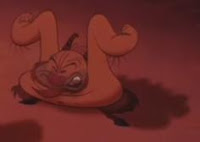
He started it form the start with the seven dwarfs (doc, dopey and grumpy). This technique gives characters or objects a cartoony feel to their movement.
"Squash and Stretch -- Defining the rigidity and mass of an object by distorting its shape during an action." - John Lasseter
Squash and stretch is very important in all animations and is usually applied on fleshy, rubberly, fexilble etc objects or even certain type of cloth. Rigid objects like a chair will not use this technique unless the character as "Alive" (like the chair in Beauty and the Beast".)
There are different reasons for using this technique. It can be used to get a more flowing feel to certain movements and gives the object more realism and weight. For example, when a character is jumping up, his/her body will
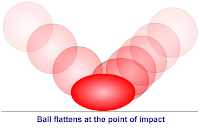 stretch up.
stretch up.Sometimes, the animators will exaggerte with the squash and stretch to emphasis the power behind the movement.
Stretching objects like a bounching ball just before and after it touches the ground gives the illusion of great speed behind the bounce.
However, when using this rule, an important thing to remember is the volume of the squashed/ stretched object will never change.
A good example of this squash and stretch technique is a bouncing ball.
Exaggeration:-
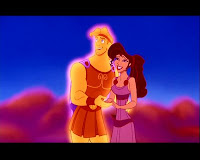
Most animations tend to use some exaggeration to show off actions or characteristics of a character or object. It helps the audience understand easier what is being portrayed. If a character is angry, then it is often a good idea to exaggerate his/her emotion by making him furious so the audience can get a feel of the important points. Or if the animator wants to make a point clear that a character is tired, then they can make him/her yawn and stretch out their arms and slightly tilt their head back to give the tiredness more strength.
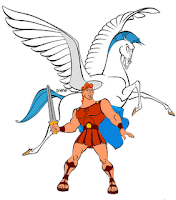 It doesn’t not only have to be characters, exaggerated objects can work too. An example of exaggeration in a Disney film would be Hercules. Hercules’ muscle and waste is a clear sign. The reason why he was given a heavy top and narrow bottom was to make his strength stand out.
It doesn’t not only have to be characters, exaggerated objects can work too. An example of exaggeration in a Disney film would be Hercules. Hercules’ muscle and waste is a clear sign. The reason why he was given a heavy top and narrow bottom was to make his strength stand out. However, too much exaggeration can be a bad thing too as it clouds the more powerful scenes - will not make the important scenes stand out. So a balance is require so the audience can see what is really exaggerated and what is not.
Anticipation:-
There are three parts to Anticipation.
- The before (usually backward motion) is the anticipation
- The actual action
- The end of the action
Anticipation is required to prepare the viewer for what’s about to happen - usually something major or important. For example, when a character’s about to deliver a powerful kick, he/she will bring his/her leg back (anticipation) for momentum before they actually perform the kick/ connect with the object they are about to kick.
It attracts the viewers attention (to a particular part of the screen if required) and prepares us so the viewers know what will happen - less confusion for the viewers.
Anticipation also helps portray the weight of a heavy object. For example, if a character needs to pick something up from the ground, he/she will bend down low as possible, with legs spread out for good balance, lift from the bottom and strain to lift it up. Whereas if he/she was to pick up a matchbox from the ground, all he/she needs to do is bend down to pick it up with little effort.
Follow Through and Overlapping Action:-
"Things do not come to a stop all at once…; first there’s one part and then another." - Walt Disney
Follow Through is when the main body of a character suddenly stops while the rest of its body or accessories continue to move on. For example, if we imagine a long haired heroine flying forward in the air, she suddenly stops. Her hair, cape etc would still move forward because like Walt Disney said, things do not stop all at once. An example can be seen in Scooby Doo, when Scooby’s running away from a monster and suddenly stops and turns round but his tail carries on moving forward. 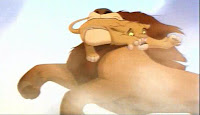
Here is a screenshot from The Lion King (1994). Mufasa’s saving Simba from the wildebeest. Simba was flying towards the bottom right of the screen but because Mufasa suddenly grabbed him and changed his direction, Simba’s tail has not caught up yet and is still moving in the original direction. Follow Through helps make an animation more realistic. It can help express the power, speed or suddenness of the movement. However, timing will have to be planned out carefully or it will not look right.
Overlapping keeps a continuous flow between actions and so makes objects seem more natural and exciting.
Lip ~ Synch:-
Lip synch is a very hard thing to get right in any animation. If it is not done right then it can ruin a very good piece of animation (unless the creator is after that effect for humour). The only way to get it right is it say it yourself in front of a mirror. Or ask someone to say the words and you watch their mouth movements carefully. However, with today’s technology, animation programs like Toon Boom will automatically lip synch your words for you - making it easier but it is still a good idea to learn it the old fashion way to get a better understanding.
When we say a sentence, we do not pronounce every single letter nor do we say each word clearly. In animation, we do not lip synch letters, but sound. Animating each syllable instead of letters will not work either, other wise the mouth will be moving far too much for it to be realistic. Most of the words in the sentence merges together so it can be difficult to see which mouth movement we actually need. So when we animate the mouth, we need to actually see and say out loud what we want to animate in order to get it right. There are approximately 44 phonemes in the English language.
Here are some basic phonemes.

~ Message from the little elf ~

No comments:
Post a Comment